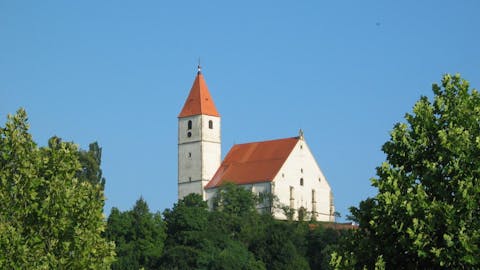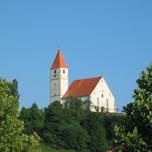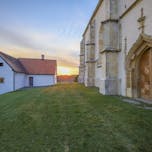
BENEDIKT MUNICIPALITY
Church of St. Trije Kralji and sacristan’s house
The Church of St. Trije Kralji stands on a 305-meter-high hill and was permitted to be built by Archbishop Matthäus Lang von Wellenburg of Salzburg in 1521, as a subsidiary pilgrimage church. Between 1521 and 1528 the parishioners first constructed a single-nave church. The shell of the present church, or at least of the nave, was probably completed in 1558. In the second half of the 16th century, the bell tower was built and both side aisles were vaulted (the presbytery was vaulted only in 1564, while the nave was vaulted in 1577). In the following centuries (in 1756 or 1757) the sacristy with an oratory was added. Between 1902 and 1903, both the interior and exterior were completely renovated.
The late Gothic three-aisled church ranks among the largest artistic monuments in Slovenia. Four exterior portals are adorned with buttresses and a cornice wall that breaks at right angles above the doors and below the windows. The bell tower rises one storey higher than the roof ridge and has an added stair turret. The entrances to the church from the south, west, and north are represented by three richly articulated portals, while the fourth, in the southern wall of the presbytery, is simpler. Above the western portal is the year 1558.


The interior is a three-part stepped hall. The pillars are octagonal, with concavely chamfered sides and geometrically decorated bases. The vault of the main nave rests on corbelled shafts that branch at the top into an interwoven ribbed network. The vaulting scheme is an interlacing of cross-rib vaults over one and two bays. In the side aisles the vaults are cross-ribbed, with shafts reaching down to the floor. On the keystones of the main nave are the date 1577, the name Lucas Novakh, a master’s mark, and the initials GJ or CJ. The presbytery is broad and rather low; the ribs are carried by polygonal shafts with Renaissance capitals. Its vaulting scheme forms a rhomboid star. On the keystones are the symbols of the Evangelists and the date 1564. The altars are of particular value. The oldest is the Altar of the Nativity, a characteristic Gothic winged altar. In its central niche is a Nativity scene with a depiction of the genealogy of Christ. Another, simpler altar from around 1620 is dedicated to the Trije Kralji. The Renaissance Altar of the Assumption of Mary was made in 1611 by the Maribor joiner Georg Stützl, while the sculptural group of the Assumption, a few decades younger (1636), represents the golden altars of the 17th century. Also notable is the stone pulpit with reliefs, standing by a column next to the triumphal arch.